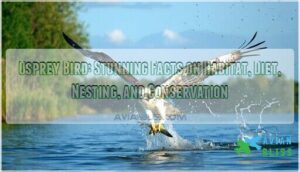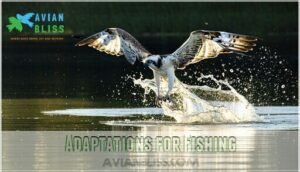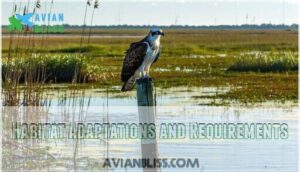This site is supported by our readers. We may earn a commission, at no cost to you, if you purchase through links.

This powerhouse of the sky hunts over lakes and rivers, always eyeing its next meal—fish.
You might spot its nest, built up high with twigs and anything else it finds handy.
Ospreys live on almost every continent, never tied down, always answering the call of open water.
Their skills make you wish you could grab a snack with a splash too, and experience the thrill of feathers and freedom.
Stick around if you want the secret life of the osprey bird, feathers and freedom included.
Table Of Contents
- Key Takeaways
- Osprey Physical Traits
- Osprey Habitat Range
- Osprey Diet Hunting
- Osprey Nesting Breeding
- Osprey Conservation Status
- Frequently Asked Questions (FAQs)
- Is it rare to see an osprey?
- What states are ospreys found in?
- What is so special about osprey?
- Is an osprey a hawk or an eagle?
- How do you tell if a bird is an osprey?
- Do ospreys make any distinctive calls or sounds?
- How do ospreys interact with other bird species?
- What are common behaviors of ospreys in the wild?
- How do ospreys find their way during migration?
- What is the lifespan of an osprey in the wild?
- Conclusion
Key Takeaways
- You’ll spot ospreys almost anywhere there’s water, thanks to their global range and talent for thriving near lakes, rivers, and coasts.
- If you see a big bird with M-shaped wings, a dark eye stripe, and a fierce dive into the water for fish, you’re watching an osprey in action.
- Ospreys are expert anglers, using specialized vision, talons, and flight techniques to catch fish with impressive accuracy and speed.
- Conservation efforts brought ospreys back from the brink, but they still face threats like habitat loss, pollution, and climate change—your awareness helps keep them soaring.
Osprey Physical Traits
You’ll spot an osprey by its long, narrow wings, dark eye stripe, and white underparts—it looks a bit like it’s wearing sunglasses.
These birds aren’t just big; their strong legs, hooked beak, and sharp talons make them fish-catching experts.
Body Measurements and Plumage
Three facts make osprey body measurements and plumage easy to spot.
- Ospreys are big—think goose-sized—with a length of 21–25 inches and weighing 3–4.4 pounds.
- Juvenile plumage shows buff-tipped feathers and orange eyes, adults flash yellow eyes.
- The bird color pattern features brown backs, white underparts, and a bold dark eye stripe.
Distinctive Flight Profile and Wingspan
Ever spot an osprey bird carving the sky with M-shaped wings? Its wingspan stretches up to six feet, giving it exceptional soaring abilities and serious flight speed.
You’ll see them hover above water, mastering the hovering technique with ease. These migration patterns take them far and wide—truly, bird wingspan like this turns every breeze into an open highway.
Eagles, however, have larger wingspans, reaching up to 7.5 feet, which is a notable difference in terms of wingspan.
Adaptations for Fishing
When you watch an osprey bird snag fish, you’re seeing special fishing gear in action.
Here’s the scoop:
- Reversible Toes and Barbed Talons grip even wriggly fish tight.
- Closable Nostrils keep water out during epic dives.
- Specialized Vision helps spot lunch from high above.
A true master of osprey fishing, perfectly evolved for a fisheating lifestyle!
Osprey Habitat Range
You’ll spot ospreys on every continent except Antarctica, as long as there’s a big body of water nearby.
These birds aren’t picky—they’ll set up home by lakes, rivers, or coastlines, making them real world travelers.
Geographic Distribution and Range
You’ll spot the osprey bird almost anywhere water and fish mingle.
Ospreys have a global distribution—think every continent but Antarctica.
Their continental range stretches across beaches, rivers, and lakes, showing real freedom in their migration patterns.
From north to south, habitat variations and coastal distribution let ospreys spread their wings, making them true masters of worldwide distribution and range.
Types of Water and Regions
When you’re near rivers, lakes, or the coast, keep your eyes peeled for ospreys.
These birds aren’t picky—they master life in Coastal Habitats, Freshwater Ecosystems, and even Brackish Regions.
With a knack for flying over freshwater wetlands and saltwater wetlands alike, their Global Distribution stretches far and wide, making riverine areas prime real estate for hunting.
Osprey habitats, like other bird habitats, face threats from habitat loss and fragmentation.
Habitat Adaptations and Requirements
If you’re eyeing a master of freedom, look to the osprey.
They stick close to water proximity, adapting their osprey habitat to lakes, coasts, or rivers worldwide.
They favor high nesting structures, controlling territories that match their osprey fishing style.
Thanks to climate influence and global distribution, you’ll find their bird adaptations work anywhere their osprey diet thrives.
Osprey Diet Hunting
You’ll spot the osprey gliding over lakes and rivers, watching for fish near the water’s surface.
These sharp-eyed hunters use special skills and strong talons to snatch slippery fish in seconds—much faster than your pet cat catches a treat.
Primary Food Source and Hunting Success Rate
If you’ve ever wondered about the osprey diet, it’s all about fish.
These birds use smart hunting techniques to catch their meals, landing fish sized just right for a powerful grip.
Their catch frequency is impressive, with some snatching a fish every 12 minutes.
Success factors like clear water and calm winds keep osprey fishing nearly foolproof.
Ospreys’ hunting success depends on various environmental factors, like water depth and wind speed, which are critical to their hunting success.
Techniques for Locating and Catching Fish
After learning what ospreys eat, you might wonder how these piscivorous birds get their meals.
Here’s how:
- Master the Hovering Technique over water.
- Use sharp eyes for Fish Identification.
- Trigger swift Diving Mechanics feet-first.
- Rely on a strong Talon Grip for slippery prey.
- Turn the fish head-first in flight for Drag Reduction.
Ospreys are most active during dawn and dusk, utilizing their unique hunting skills to catch their prey with swift movements.
Hunting in Shallow Waters and Regional Variations
Ever wonder why ospreys love shallow water hunting? Their talons, special underwater vision, and knack for adjusting to refraction let them reel in prey with style.
Regional diet shifts mean they munch on whatever’s biting—catfish, perch, or herring. Foraging adaptations boost hunting success, so whether in Florida or New York, ospreys master regional differences like pros.
These birds, also known as river and fish hawks, have a diverse range of names, showcasing their unique ability to thrive in various environments with their special underwater vision.
Osprey Nesting Breeding
You’ll find that ospreys build huge nests using all sorts of sticks and random treasures they discover near water.
These hardworking birds pair up for life, raising their chicks together with teamwork that would make any family proud, demonstrating hardworking qualities.
Nest Construction and Materials
After a good meal, ospreys get right to work on a sturdy bird nest. You’ll spot their Nest Locations high up—old trees, utility poles, or cliff ledges.
The average Nest Size can rival a coffee table and grows each year. Ospreys often reuse and add to older nests, with some lasting decades.
To fortify their nests, ospreys need durable nesting materials.
- Sticks and seaweed
- Bulky, haphazard structure
- Lined with grasses, moss
- Nest Reuse every season
Mating and Incubation Patterns
Once the sticks are stacked and the nest feels sturdy, you’ll spot osprey courtship rituals—high flight displays and sky-dancing.
These breeding pairs often become lifelong mates, with mating rituals kicking off the nesting behavior each season.
Egg laying soon follows, leading to a busy incubation period. After about five weeks of steady warmth, eggs show first signs of chick development.
Parental Care and Incubation Responsibilities
Parent birds are like tag-team champions at the nest site.
Here’s what boosts nestling survival:
- Parental roles split—Mom keeps the eggs warm during incubation; Dad hunts for fish.
- Feeding frequency ramps up after hatching; chicks depend on regular meals.
- Egg asynchrony means some young get a head start, but teamwork helps every chick stand a chance.
The key factors include parental roles, feeding frequency, and egg asynchrony, which all contribute to nestling survival, with parental care being crucial.
Osprey Conservation Status
You might be surprised to learn that ospreys once faced serious trouble because of pollution and habitat loss.
Ospreys battled pollution and shrinking habitats, but their remarkable recovery shows what conservation and caring people can achieve.
Today, these skilled fishing birds are making a comeback, thanks to smart conservation work and a little help from people who care.
Historical Threats and Decline
As osprey birds settled into their colossal nests, big trouble began brewing.
Decades ago, pesticides like DDT invaded waterways, causing eggshell thinning and major population crashes.
Habitat loss and a persecution history added fuel to the fire, putting osprey conservation at risk.
When their numbers dropped, folks began to wonder: would these masters of the sky ever soar in strength again?
Their decline mirrors the fact that 78% face extinction due to similar factors, highlighting the need for bird conservation and awareness of the extinction threats.
Recovery Efforts and Pesticide Regulation
After years of DDT impact and sharp declines, you’ll see how osprey conservation swung into high gear.
Legal protections kicked in, and banning dangerous pesticides helped recovery soar.
You can find more information about osprey pesticide products online.
Folks built nest platforms, offering birds a real shot at mastering parenthood, thanks to bold conservation efforts, bird population rebounds became real—though future challenges will still test these powerful raptors’ freedom.
Current Conservation Status and Threats
Caught between a rock and a hard place, ospreys face threats like Habitat Loss, Climate Change, and tangled Fishing Nets.
Resilient yet vulnerable, ospreys navigate shrinking habitats, warming climates, and treacherous fishing nets with every soaring flight.
Even with conservation efforts, their conservation status isn’t all smooth sailing—Pesticide Impact still lingers, and Human Disturbance stirs up trouble.
Staying sharp about osprey conservation means watching for changes, fixing problems early, and making sure everyone plays their part to address Climate Change.
Frequently Asked Questions (FAQs)
Is it rare to see an osprey?
Seeing something as powerful as a fisherman soaring above lakes isn’t as rare as you’d think—if you hang out near big water.
Stick to rivers and coastlines, and you’ll likely catch this skilled hunter in action.
What states are ospreys found in?
You’ll find these skilled fishers in almost every U.S. state, soaring over lakes, rivers, and coastlines from Florida to Alaska.
If there’s water and lunch to catch, they’ve likely called that state home at some point.
What is so special about osprey?
You get a master angler in the sky—this bird can spot fish from high up, dive feet-first, and snatch dinner with razor-sharp talons.
Its unique M-shaped wings make it easy to tell apart, with razor-sharp talons being a key feature.
Is an osprey a hawk or an eagle?
Scan the skies for winged hunters and you’ll spot ospreys standing apart—neither true hawk nor eagle.
They’re actually a unique type of raptor, set in their own family, built almost entirely for fishing glory.
How do you tell if a bird is an osprey?
Look for a big bird with long, narrow wings that form an “M” in flight, a white belly, dark eye stripe, and hooked beak.
It hovers over water then dives feet-first for fish.
That’s your osprey!
Do ospreys make any distinctive calls or sounds?
Like a secret code breaker, you’ll spot them by a sharp “cheep” or whistling “chirp,” often repeated.
These high, piercing calls help them communicate with mates and defend their territory—no mistaking that voice!
How do ospreys interact with other bird species?
You’ll see these hawks flex their muscle around other birds, often defending nests or fishing spots with fierce dives.
They rarely team up but sometimes tolerate gulls and crows nearby—just don’t expect them to share supper.
What are common behaviors of ospreys in the wild?
You’ll spot these birds soaring high, scanning for fish, then diving feet-first into water with laser focus.
They’re expert anglers, building giant stick nests near water.
Teamwork rules—parents share feeding and guarding, giving their chicks a fighting chance.
How do ospreys find their way during migration?
Who needs Google Maps?
You’d use the sun, stars, and Earth’s magnetic fields to chart a path each fall.
Instincts and environmental clues guide you like a wise old compass, helping you travel thousands of miles with precision.
What is the lifespan of an osprey in the wild?
You’ll find an osprey cruising the skies for about 20 to 25 years out in the wild.
If luck’s on their side and fish are plenty, these raptors can outlast the average bird’s retirement plan!
Conclusion
Did you know the osprey bird can catch fish with a success rate of up to 70%? These skilled hunters aren’t just talented—they’re survivors, found on every continent except Antarctica.
When you watch an osprey bird soar or dive, you’re seeing a true specialist in action. Now that you know their secrets, you can spot their nests, understand their habits, and help protect their habitats.
Next time you’re near water, keep an eye out for this marvelous raptor.












